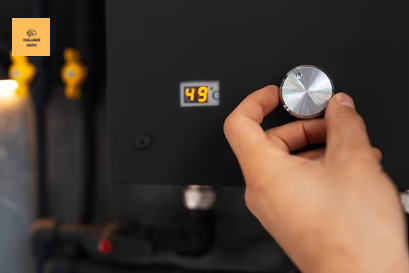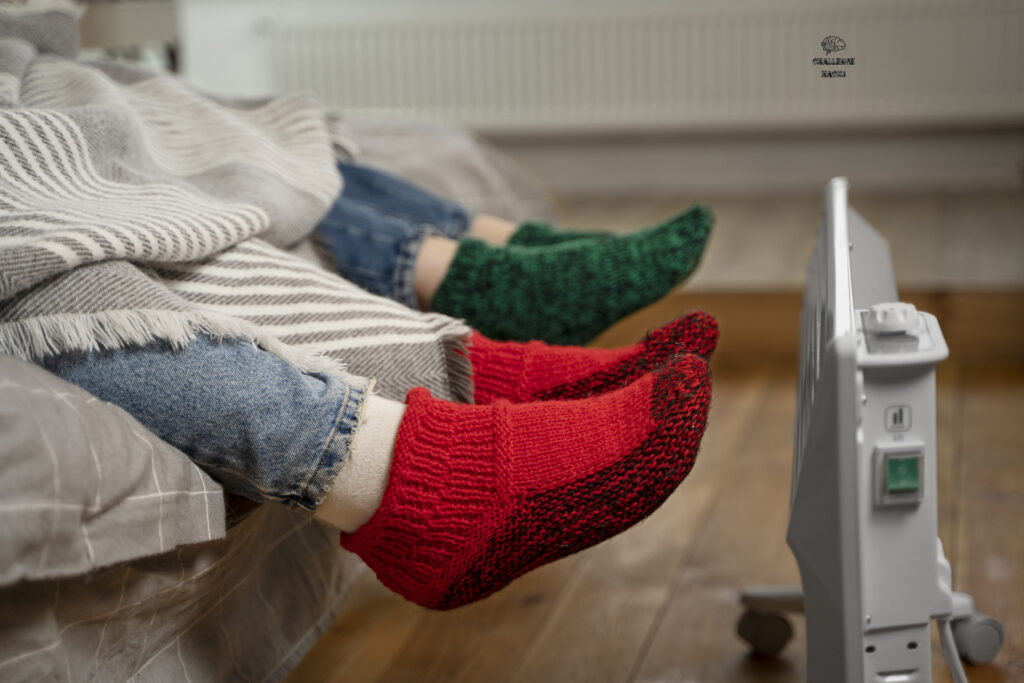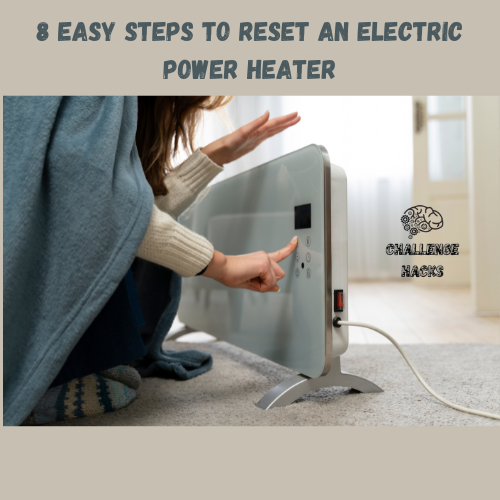
An electric power heater is a device utilizing electricity to heat water for various purposes like bathing, washing, and cooking. While these heaters are known for their convenience and efficiency, they may encounter malfunctions due to factors such as power surges, overheating, or faulty wiring. When issues arise, you might observe insufficient hot water, unusual noises, or signs of leakage or smoke.
In some instances, seeking professional assistance from a plumber or electrician may be necessary, but often, a simple reset of your electric power heater can restore normal functionality. Resetting the electric power heater is a straightforward and safe process, offering a time and cost-effective solution. Here are eight easy steps to reset an electric power heater:
Step 1: Turn off the power supply
The first and most important step to reset an electric power heater is to turn off the power supply. By doing this, you can avoid getting hurt or shocked by electricity when servicing the heater. Either unplugging the heater from the wall outlet or turning off the circuit breaker that regulates the heater will cut off the power supply. Verify which circuit breaker, if any, is connected to your heater and, if required, mark it. Before moving on to the following step, make sure the power is off by using a voltage tester.
Step 2: Locate the reset button
Finding the reset button on your electric power heater is the next step to reset an electric power heater. Usually situated next to the thermostat or heating element, the reset button is a tiny button with a typical color scheme of red or black. The thermostat regulates and keeps the water’s temperature stable, while the heating element heats the water.
Depending on the model and type of your heater, the reset button may be on the front, back, side, or top of the heater. You may need to remove a cover or a panel to access the reset button. Refer to your heater’s manual or look online for the specific location of the reset button for your heater.
Step 3: Press the reset button
To reset an electric power heater, follow these steps: first, hit the reset button on the heater. The button can be recessed or difficult to reach, so you might need to use a screwdriver, a pen, or something similar to press it. Firmly press and hold the button for a few seconds, then let go. The heater has been reset, and you should hear a click or beep sound. Try pressing the button again or make sure the power is off if there is no sound or if it does not pop out.
Step 4: Turn on the power supply
To initiate or reset an electric power heater, adhere to the following steps: initially, activate the heater’s power source. This can be achieved by either reconnecting the heater to the wall socket or switching on the circuit breaker that controls the heater. Allow the heater a few minutes to warm up, restoring its regular functionality.
Step 5: Test the water temperature
Testing the water’s temperature to determine whether the heater is operating correctly is the fifth step (reset an electric power heater). To accomplish this, turn on the water and let it run for a few minutes through a faucet or shower that is linked to the heater. Check the water’s temperature with your hand or a thermometer. It shouldn’t be boiling or scorching hot—just hot enough to suit your tastes. You might need to repeat the reset procedure or change the thermostat if the water is excessively hot or cold.
Step 6: Adjust the thermostat
If the water temperature is not at an acceptable level, the sixth step is to reset an electric power heater. The thermostat, which regulates the water’s temperature, is typically found next to the heating element or reset button. You can adjust the desired temperature on the thermostat using a dial, knob, slider, or digital display, depending on the make and model of your heater.

For detailed instructions on how to modify the thermostat on your heater, consult the owner’s manual or search online. To access the thermostat, you might need to use a screwdriver or other comparable instrument. Take caution not to come into contact with any hot or live parts or cables. Allow the heater to adjust for a few minutes after turning the thermostat slightly in the direction that corresponds to the desired temperature. Once you’ve reached the ideal temperature, test the water one more and keep going till you get there.
Step 7: Check for leaks or other issues
Examining your electric power heater for leaks or other problems that can compromise its functionality or safety is the seventh stage to reset an Electric Power Heater. Examining the heater and the pipes that connect it to the water supply will enable you to accomplish this. Keep an eye out for any indications of water leakage, corrosion, rusting, cracking, or bulging. Turn off the heater’s electricity and water supply if you find any leaks or damage, then contact a qualified plumber or electrician to address the issue. You run the risk of doing additional harm or getting hurt if you try to fix the heater yourself.
Step 8: Repeat the process if necessary
The eighth and last step to reset an Electric Power heater is to repeat the process if necessary. You might need to reset an electric power heater again or look into other options if the reset button doesn’t work, the water temperature doesn’t change, or the heater exhibits other symptoms of a problem. The following are some possible reasons and fixes for an electric power heater that isn’t working properly:
- The heating element is burnt out or damaged: Consider replacing the heating element or the entire heater.
- The thermostat is faulty or misaligned: Explore options to replace or recalibrate the thermostat or the entire heater.
- Water pressure is too low or too high: Adjust the water pressure regulator or the water valve controlling the water flow to the heater.
- Unstable or insufficient power supply: Inspect the voltage, wiring, fuse, or circuit breaker supplying power to the heater.
- The heater is too old or too small: Upgrade to a newer or larger heater capable of meeting your hot water demand.
If uncertainty persists regarding the cause or solution, seeking advice and assistance from a professional plumber or electrician is recommended.

Pros and Cons of Reset an Electric Power Heater
| Pros | Cons |
|---|---|
| Simple and quick process | May not address underlying issues causing the malfunction |
| Cost-effective solution | Temporary fixes and issues may reoccur |
| No need for professional assistance | Not suitable for complex or severe malfunctions |
| Minimal downtime for hot water supply | Limited effectiveness for certain heater problems |
| Environmentally friendly | May require repeated resets for persistent issues |
Conclusion
In summary, resetting an electric power heater with the outlined 8 steps is a quick fix for common issues. If problems persist, consult a professional plumber or electrician. Adopt preventive measures, like surge protectors and regular maintenance, to minimize reset an electric power heater. Compare the pros and cons of electric heaters with alternatives, considering factors like budget and features. Choose a brand or model that aligns with your needs. We hope this article proves helpful. For queries or comments, please share below. Thank you! 😊
Y0U MAY LIKE THIS Hive Thermostat Acting Up? Here’s to Fix it! Easily
How often should I reset my electric power heater?
There is no definitive answer to this question, as it depends on the condition and performance of your heater. However, some general guidelines are:
You should reset your heater if you notice any signs of malfunctioning, such as low or no hot water, strange noises, leaks, smoke, etc.
You should reset your heater at least once a year, as part of your regular maintenance routine. This will help to clear any sediment or mineral buildup that could affect the efficiency or lifespan of your heater.
You should reset your heater after any power outage or surge, as this could cause the heater to trip or malfunction.
How long does it take to reset an electric power heater?
To Reset an electric power heater is usually quick and easy, and it should not take more than 15 minutes. However, the actual time may vary depending on the model and type of your heater, the location and accessibility of the reset button and the thermostat, and the water temperature and pressure.
How can I prevent my electric power heater from tripping or malfunctioning?
To safeguard your electric power heater from tripping or malfunctions:
Regular Check-ups: Schedule routine maintenance checks.
Moderate Temperature: Avoid setting excessively high thermostat temperatures.
Secure Wiring: Ensure safe and correct wiring.
Avoid Overloading: Be cautious of overloading circuits.
Monitor Pressure: Keep an eye on water pressure levels.
Prompt Repairs: Address issues promptly to prevent escalation.
Professional Inspections: Periodically seek professional inspections.
Clear Surroundings: Maintain a clutter-free area for proper ventilation.
Implementing these measures enhances your electric power heater’s reliability and longevity.
What are the alternatives to electric power heaters?
Explore various alternatives to electric power heaters based on your needs:
Gas Water Heaters: Cost-effective option using natural gas or propane.
Tankless Water Heaters: On-demand heating for energy efficiency.
Solar Water Heaters: Harness solar energy for eco-friendly heating.
Heat Pump Water Heaters: Extract heat from air or ground for efficiency.
Hybrid Water Heaters: Blend heat pump tech with traditional elements.
Propane Water Heaters: Propane-fueled alternative to gas heaters.
Oil Water Heaters: Utilizes heating oil, common in certain regions.
Wood/Pellet Water Heaters: Renewable heat source for off-grid living.
Consider factors like energy efficiency, fuel availability, and environmental impact when selecting the right alternative for your specific requirements.
What are the best brands or models of electric power heaters?
Consider these reputable brands for electric power heaters:
Rheem: Reliable and efficient water heaters.
Ecosmart: Emphasizes energy efficiency with tankless options.
A.O. Smith: Known for durable and high-performance heaters.
Bradford White: Offers innovative solutions for both residential and commercial use.
Stiebel Eltron: German-engineered tankless electric water heaters.
Westinghouse: Noted for durable and efficient electric water heaters.
Bosch: Provides reliable and energy-efficient tankless options.
Reliance: Well-established brand offering versatile electric water heaters.
Always check the latest reviews and specifications to ensure a chosen model aligns with your specific requirements.
1 thought on “8 Easy Steps to Reset an Electric Power Heater”